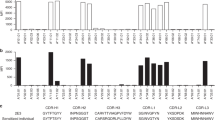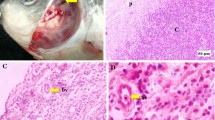Abstract
Class I-like molecules have been immunoprecipitated from Xenopus leukocytes and erythrocytes with alloantisera directed against major histocompatibility complex (MHC)-linked antigens. The heavy chains, depending on the allele examined, have molecular weights of 40 000–44 000 of which 3000 daltons are asparagine-linked carbohydrates, probably present as one N-linked glycan. The presumed analogue of β 2-microglobulin has a molecular weight of 13 000 and bears no asparagine-linked glycans. Family studies show that the heavy chains are encoded by genes residing in or closely linked to the MHC.
Similar content being viewed by others
Abbreviations
- MHC:
-
major histocompatibility complex
- CML:
-
cell-mediated lympholysis
- MLR:
-
mixed leukocyte reaction
- APBS:
-
amphibian phosphate-buffered saline
- kd:
-
kilodalton
- LG:
-
Xenopus laevis — Xenopus gilli species hybrids
- IEF:
-
isoelectric focusing
References
Bernard, C. C. A., Bordmann, G., Blomberg, B., and Du Pasquier, L.: Immunogenetic studies on the cell-mediated cytotoxicity in the clawed toad Xenopus laevis. Immunogenetics 9: 443–454, 1979
Bernard, C. C. A., Bordmann, G., Blomberg, B., and Du Pasquier, L.: Genetic control of T helper function in the clawed toad Xenopus laevis. Eur. J. Immunol. 11: 151–155, 1981
Bernardini, N., Chardonnens, X., and Simon, D.: Dévelopement après la metamorphose de compétences immunologiques envers les homogreffes cutanées chez des Xenopus laevis Daudin. C. R. Acad. Sci. 269: 1011–1014, 1969
Bonner, W. and Lasky, R.: A film detection method for tritium-labeled proteins and nucleic acids in polyacrylamide gels. Eur. J. Biochem. 46: 83–88, 1974
Cone, R. E. and Marchalonis, J. J.: Surface proteins of thymus derived and bone marrow derived lymphocytes. Selective isolation of immunoglobulins and antigen by non-ionic detergents. Biochem. J. 104: 435–447, 1974
Du Pasquier, L. and Chardonnens, X.: Genetic aspects of the tolerance to allografts induced at metamorphosis in the toad Xenopus laevis. Immunogenetics 2: 431–440, 1975
Du Pasquier, L.: Ontogeny of immunological functions in amphibians. In N. Cohen and M. Sigel (eds.): The Reticuloendothelial System, pp. 633–657, Plenum Publishing Corp., New York, 1982
Du Pasquier, L., Chardonnens, X., and Miggiano, V. C.: A major histocompatibility complex in the toad Xenopus laevis (Daudin). Immunogenetics 1: 482–494, 1975
Du Pasquier, L., Blomberg, B., and Bernard, C. C.A.: Ontogeny of immunity in amphibians: Changes in antibody repertoires and appearance of adult major histocompatibility antigens in Xenopus. Eur. J. Immunol. 9: 900–906, 1979
Flaherty, L.: Genes of the Tla region: The new Qa system of antigens. In H. C. Morse (ed.): Origin of Inbred Mice, pp. 409–422, Academic Press, New York, 1978
Flajnik, M. F.: The Xenopus Major Histocompatibility Complex. Ph. D. thesis, University of Rochester, Rochester, New York, 1983
Galfrè, G., Howe, S. C., Milstein, C., Butcher, G. W., and Howard, J. C.: Antibodies to major histocompatibility antigens produced by hybrid lines. Nature 266: 550–552, 1977
Gordon, S. M. and Kindt, T. J.: Detection of β 2-microglobulin in sera from diverse vertebrates by the use of a heterologous radioimmunoassay. Scand. J. Immunol. 5: 505–511, 1976
Götze, D. (ed.): The Major Histocompatibility System in Man and Animals, Springer Verlag, Berlin, 1977
Hsu, E. and Du Pasquier, L.: Studies on Xenopus immunoglobulins using monoclonal antibodies. Mol. Immunol. 21: 257–270, 1984
Kessler, S. W.: Rapid isolation of antigens from cells with a staphylococcal protein antibody adsorbent: Parameters of the interaction of antigen-antibody complexes with protein A. J. Immunol. 115: 1617–1624, 1975
Klein, J.: The major histocompatibility complex of the mouse. Science 203: 516–521, 1979
Klein, J., Juretić, A., Baxevanis, C. N., and Nagy, Z. A.: The traditional and new version of the mouse H-2 complex. Nature 291: 455–459, 1981
Kobel, H. R. and Du Pasquier, L.: Production of large clones of histocompatible, fully identical clawed toads (Xenopus). Immunogenetics 2: 87–91, 1975
Kobel, H. R. and Du Pasquier, L.: Hyperdiploid species hybrids for gene mapping in Xenopus. Nature 279: 157–158, 1979
Laemmli, U. K.: Cleavage of structural proteins during the assembly of the head of bacteriophage T4. Nature 227: 680–685, 1970
Pink, J. R. L., Droege, W., Hála, K., Miggiano, V., and Ziegler, A.: A three-locus model for the chicken major histocompatibility complex. Immunogenetics 5: 203–216, 1977
Ploegh, H. L., Orr, H. J., and Strominger, J.: Major histocompatibility antigens: The human (HLA-A, -B, -C) and murine (H-2K, H-2D) class I molecules. Cell 24: 287–299, 1981
Roch, P., Cooper, E., and Eskinazi, D. P.: Serological evidences for a membrane structure related to human β 2 microglobulin expressed by certain earthworm leucocytes. Eur. J. Immunol. 13: 1037–1042, 1983
Shalev, A., Greenberg, A. H., Lögdberg, L., and Björk, L.: β 2-microglobulin-like molecules in low vertebrates and invertebrates. J. Immunol. 127: 1186–1191, 1981
Shalev, A., Pla, M., Vogel, Echalier, G., Lögdberg, L., Colonbani, J., and Segal, S.: Evidence for β 2 microglobulin and H-2 determinants in Drosophila. J. Immunol. 130: 297–302, 1983
Tochinai, S. and Katagiri, C.: Complete abrogation of immune response to skin allografts and rabbit erythrocytes in the early thymectomized Xenopus. Dev. Growth Differen. 17: 383–394, 1975
Tracy, J. and Lampen, J. O.: Tunicamycin inhibition of polyisophenyl N-acetylglucosaminyl pyrophosphate formation in calf liver microsomes. Biochem. Biophys. Res. Commun. 65: 248–257, 1975
Warr, G. W., Rosenshein, I. L., and DeLuca, D.: β 2-microglobulin-like polypeptide of the goldfish, Carassius auratus. Mol. Immunol. 21: 105–108, 1984
Weiss, N. and Du Pasquier, L.: Factors effecting the reactivity of amphibian lymphocytes in a miniaturized technique of the mixed lymphocyte culture. J. Immunol. Methods 3: 273–286, 1973
Author information
Authors and Affiliations
Additional information
Founded and supported by F. Hoffmann-La Roche & Co., Limited Company, CH-4005 Basel, Switzerland.
Rights and permissions
About this article
Cite this article
Flajnik, M.F., Kaufman, J.F., Riegert, P. et al. Identification of class I major histocompatibility complex encoded molecules in the amphibian Xenopus . Immunogenetics 20, 433–442 (1984). https://doi.org/10.1007/BF00345617
Received:
Revised:
Issue Date:
DOI: https://doi.org/10.1007/BF00345617




